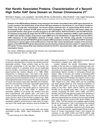TLDR The study found nine new hair protein genes in human hair follicles.
The study focused on the expression of novel keratin-associated protein 5 (KAP5) genes in the cuticle layer of human hair follicles. Hair keratin proteins and KAPs are crucial structural components of hair fibers, with KAPs functioning as disulfide bond cross-linking proteins. While previous research identified two KAP5 genes on human chromosome 11, this study mapped nine additional KAP5 members on chromosomes 11p15.5 and 11q13.5. Using RT-PCR, the expression of all KAP5 genes in hair roots was confirmed, but their detailed distribution within hair follicles was not previously explored. This study compared the expression sites of five KAP5 genes on chromosome 11q13.5 using scalp skin sections, providing new insights into their specific localization in hair follicles.
27 citations
,
April 2004 in “Biochemical and Biophysical Research Communications” Two new gene clusters important for hair formation were found on human chromosome 11.
 62 citations
,
January 2004 in “The journal of investigative dermatology/Journal of investigative dermatology”
62 citations
,
January 2004 in “The journal of investigative dermatology/Journal of investigative dermatology” A second domain of high sulfur KAP genes on chromosome 21q23 is crucial for hair structure.
28 citations
,
June 2003 in “Applied immunohistochemistry & molecular morphology” Combining cell conditioning with mild protease digestion effectively shows versican mRNA in mouse skin sections.
272 citations
,
September 2001 in “Journal of Biological Chemistry” Human hair keratins were cataloged, showing their roles in hair differentiation stages.
35 citations
,
September 1994 in “Journal of Investigative Dermatology” 15 citations
,
January 1991 in “Mammalian Genome” 67 citations
,
December 1990 in “The journal of cell biology/The Journal of cell biology” Researchers found genes for cysteine-rich proteins that form the protective layer of hair in humans and sheep.
686 citations
,
February 2002 in “Current Opinion in Cell Biology” Keratin filaments are crucial for cell structure and protection, with ongoing discoveries about their genes and functions.
